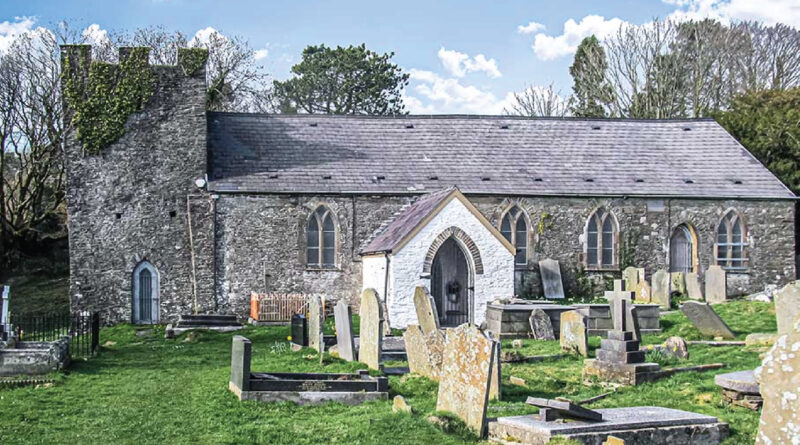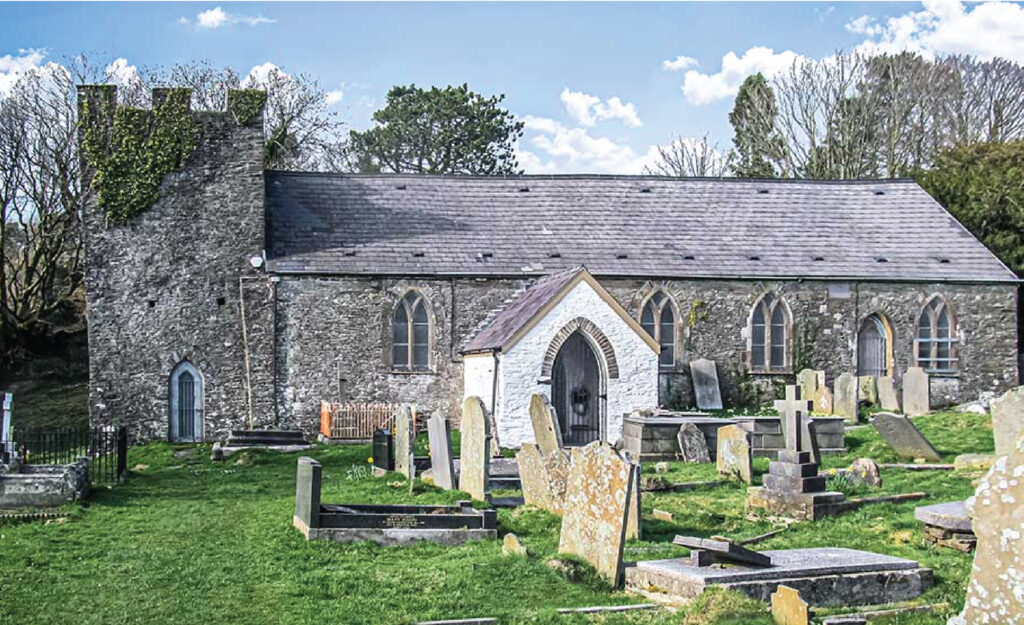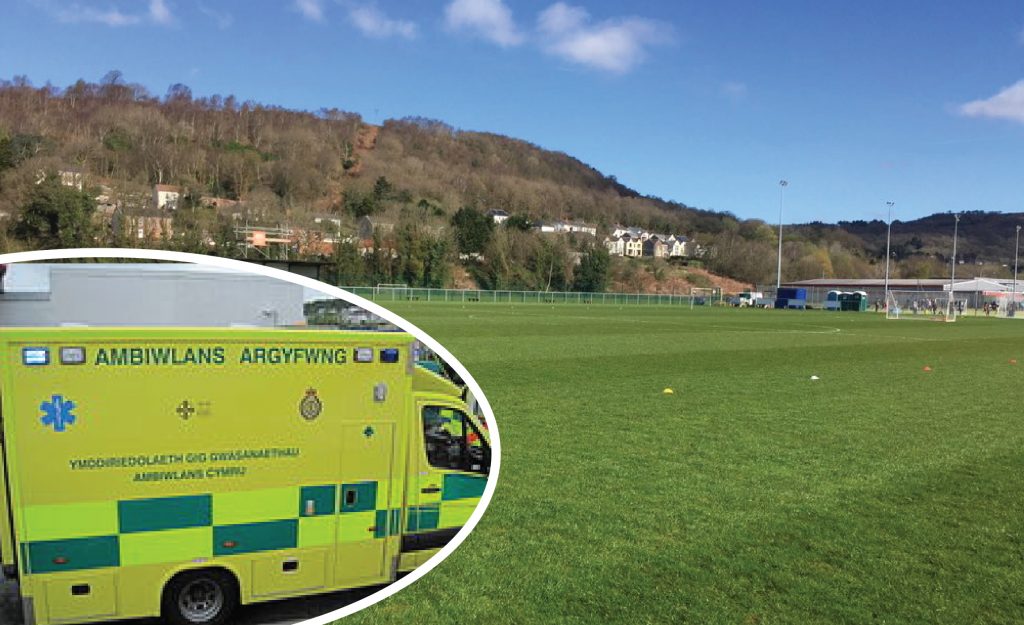Llangiwg – The lost name & history of the Swansea Valley
If any of you have stumbled across old maps of these parts (as you do), then you’d notice that the names Ystalyfera, Clydach, Morriston and Pontardawe are relatively new.
For over one thousand years, Llangiwg (with various spellings) was the geographic identity of the mid-lower Swansea Valley and I worry that we are losing that. How many know its origins and its importance?
The name goes back to the 6th century, and I wanted to know more about the word and its history.
What was the 6th Century Wales like?
Wales was rural but most of the population would have lived on the coast. Post-Roman Britain is often referred to as the Dark Ages, suggesting an uncivilised society, where we became ‘backwards after being more intellectual under Roman rule; think luxury baths, plumbed in toilets and beautifully fine granite….
It is becoming more accepted that this is not really a fair reflection. The Roman Empire was also incredibly barbaric, slavery was common, and it was often hereditary. There was a feudal style system under the Romans where the top did enjoy grapes, but the majority had incredibly little. As the Romans left, the UK was merely working out who the new ‘top dogs’ were. This inevitably led to power struggles and opportunities for new rulers!
Brychan, Brecon & Brecknockshire
In Medieval Wales, logically, the Swansea Valley should have become a part of Gower and the South/Western kingdoms, with the huge Brecon Beacons as the natural boundary to the North.
However, it didn’t. Which is something which probably still hurts the valley today (more on that later).
As the Romans left, Brychan became king of Brecknockshire. Local historian John Williams tells me “Brychan’ parents would already have been here, but we know the family had strong links with Scotland. In Scotland, women were the heads of the family. In the Anglo-Saxon system, women had no power but in Scotland, you would inherit through the mother’s side. You see in Brecknockshire that a lot of the place names are named after women.”
“The ‘sons and daughters’ of Brychan would head off and create new settlements. They would build a parish which would be named after them. Usually ‘Llan’ (saint) and then the name. We see the sons and daughters of Brychan and then the sons and daughters of them too and so on. There are hundreds of place names across Wales which were founded just after the Romans left, beginning with the word ‘Llan’.”
St Cynogs- Ystradgynlais
One of the sons of Brychan was Cynog. St Cynogs Church in Ystradgynlais remains the name today. A section from the parish website gives an insight into 6th century Swansea valley “On the outside of the boiler room wall are sections of what appear to be early Christian stones, inscribed with Latin words. They may date from the 5th or 6th centuries, when St Cynog lived. He was one of the many children of King Brychan Brycheiniog. His mother was an Irish princess, reputedly raped by Brychan.”
“Cynog received a gold bracelet from his father. A 15th-century poem tells that he used the bracelet as the decisive weapon in a fight against oppressors, who had earlier been allowed to cut a slice of flesh from Cynog’s thigh on condition they stopped harassing the locals!”
What Cynog had done in the 6th century was to expand Brecknockshire’s territory over the Brecon Beacons. Something which continues today. Ystradgynlais, remains a part of Powys, which leaves the Swansea Valley in this awkward political scenario where its slightly Swansea, slightly Neath Port Talbot, slightly Powys and if you go over a hill you end up in Carmarthenshire. Cynog delving over those Beacons and creating that settlement in Ystradgylais had huge effects on us today, but the expansion of Brecknockshire hadn’t finished.
Llan-giwg – Who was Ciwg?
Llangiwg got its name from Ciwg. Who was known as Ciwg ab Arawn or Ciwg the Confessor. He was the only known son of Arawn and Nyfain. His father, Arawn is understood to have worked promoting Christianity in the Barley hill forest in Pontardawe.
Ciwg was the great grandson of Brychan; the founder of Brecknockshire. He was also the cousin of our patron saint; Dewi Saint.
John explains the family in more detail “Ciwg’s grandfather, Cynfarch Gul, came from the old Welsh kingdom of Rheged, which was Cumbria (the land of the Cymry) and Dumfries/Galloway. Cynfarch later moved back to Rheged to become its king. Ciwg’s uncle Urien (Arawn’s brother) afterwards inherited the throne from Cynfarch. Urien was acknowledged as the greatest of the kings of the Old North, defeating the Saxons several times in battle,- a rare achievement.”
“Ciwg would have had his uncle near-by, another family member most likely in Ystradgynlais, then the king of Brecknockshire across the Beacons. This was a powerful family.”
Cadoxton and numerous churches are named after Ciwgs other uncle Cadoc. Who is also credited with teaching St Illtyd. The legend of King Arthur is entangled with the Brechan family which is essentially the ‘who’s who’ of early Wales.
Founding Llangiwg
Ciwg founded not only the church but its settlement as John explains, “before the church, the whole landscape would have been covered with trees. A small area would have been cleared to build the church and the settlement would have existed within the church walls.” There is still evidence of the remains of what could have been small houses within the walls of Llangiwg today.
“The word llan means a settlement, not ‘saint’. Llangiwg – the settlement of Ciwg. The original llan would not be a church – the association with a religious building only occurred once the settlement was established. A religious centre (possibly outdoor) was a later development inside the llan walls. Today, llan is synonymous with church, but not so in early times.”
This is important. ‘Llangiwg’ was not the name of just the church but of the settlement. In the same way as Llanelli or Llandilo. On maps right up until the last century, this place name was the defining name of these parts. It would be far larger than Pontardawe or Clydach on any map. Kings and Queens of near and far would have only known this area as Llangiwg.
Why here?
John believes that Brychan and his family migrated people from Scotland into Wales. We know that Brychan had strong Scottish links. We also know that the family ‘empire’ expanded south to Cornwall and Britany. For this reason, John thinks that the most likely way that the Scots got here was by boat.
“If you imagine migrating in the 6th century. Carrying your children and all your possessions. It would be incredibly difficult to manage that, by foot, from Scotland, all the way to Brecon. It seems far more likely that they came via the sea.”
The sea is one thing which Brecknockshire lacks. However, John thinks that Cynog’ settlement in Ystradgynlais and Ciwg’ in Pontardawe were all part of a route which linked Brecon and the sea. Llangyfelach (Saint Cyfelach) included in the route.
If the kings and queens of the kingdom of Brecknockshire were to link with Scotland, Cornwall and France, as well as Ireland then a safe passageway to the sea would have been crucial. Llangiwg could have played a vital role in that.
The Church
The 6th Century Church was not as we see it today, as churches at that time were built from wattle and daub. The first stone churches were probably built about four centuries later, following the Norman conquest of Britain. The church one sees today was substantially rebuilt in 1812 (as demonstrated by the plaque on the southern external wall), but there are remains of the Norman church on the site. Part of the tower is Norman, dating back to the 13th century.
The tower was much higher but had to be reduced in height as it was learning precariously. The belfry originally contained two bells but only one currently survives.
The church is protected as a Grade 2 Listed Building which means that the fabric cannot be altered unless permission is given by CADW. The aisle section dates to Tudor times (16th century), but this structure was refurbished in 1812. During the refurbishment, the stone slates were replaced by Caernarfon slates. The roof was again replaced in 1997.
The walls of the church are built from local sandstone with occasional old red sandstone boulders included, originating from the Brecon area. The red boulders were transported by ice movement during the last Ice Age and deposited in glacial moraines (the debris picked up and carried at the base of glaciers).
They were gathered locally and incorporated when the building was commenced.
Llangiwg was originally a Roman Catholic Church and paid homage to the Pope until the Reformation during Henry VIII’s reign in the 16th century.
Boundary disputes
In the 12th century Bernard, the Bishop of St David’s (Pembrokeshire) and Urban, the Bishop of Llandaff were involved in a dispute over the boundaries of their diocese. In 1119, and again in 1128, the Lordship of Gower, in which Llangiwg is situated, was considered to be in the diocese of Llandaff. Bishop Bernard produced new and convincing evidence that the church was in the diocese of St David’s and the Pope reconsidered his position and reversed his previous edict.
Importance of Llangiwg
The records of St David’s show that in 1563, Llangiwg was apportioned to the Hospital of the Blessed David in Swansea (where the Cross Keys Inn, Princess Way stands today). In 1754, a certain Mr Herbert had the patronage of Llangiwg and it had a £10 certificated value. In 1842, there was a perpetual curacy endowed with £600 Royal Bounty and a £1,200 Parliament Grant.
The Squires of Plas Cilybebyll collected tithes from farmers in the parish. These were unpopular taxes, particularly as the local farmers were staunch non-conformists and resented a proportion of the tax going to the Church of England. Llangiwg was the mother church of the parish and prior to the industrial revolution, the church held a central position in serving parishioners, comprising mainly of local farmers who occupied the small upland farms of the area.
The Church Records include the following documents:
· Records of baptisms 1685 – 1892
· burials 1685 – 1891
· marriages 1677 – 1837.
These records are available from the Glamorgan Family History Society. Another interesting fact is that after the morning services, some of the congregation would play ball games against the tower and then partook in the delights of the Maendy Inn, the ruins of which can be seen on the eastern side of the cemetery. Other games were played on the landoutside the cemetery wall and a local cattle fair was held there also.
Industrialised Swansea Valley
The development of industry in the valleys tended to concentrate the population on the valley floor and the trek to the services in Llangiwg Church, up the steep valley sides, focussed the minds on the creation of another church more conveniently located on the valley floor. This was the church of St Peter’s in Pontardawe. Work on its construction began in 1858 and it was completed in 1860.
The cholera epidemic of 1866 saw the graveyard at Llangiwg being used to bury victims from as far afield as Ystalyfera, as other churches refused to bury them. The poor who died in the Pontardawe
Workhouse were also buried as paupers in the graveyard at Llangiwg.
To the west of the tower lies the grave of Whitney Rhodes, who died as a pauper in the Pontardawe Workhouse. The grave is marked with a headstone (now vandalised) and this is unusual, for a pauper’s grave was rarely marked. At one time there was speculation that this Rhodes was related to Cecil Rhodes, the founder of Rhodesia but further research has clarified the situation.
Whitney Rhodes was a member of a Massachusetts family in America. He came to this country and worked in Gilbertson’s Steelworks but eventually fell on hard times and ended up in the workhouse where he eventually died. He was buried at Llangiwg initially in an unmarked grave. However, the guardians of the workhouse traced his family to America and billed them for the burial. The family also paid for the gravestone to be erected on the grave. There is a memorial to Whitney Rhodes in his hometown in America which refers to his burial as being in “Ponterdawe”.
21st Century
The last service held at Llangiwg was in 2001 at Christmas. The church was then closed. It was put up for sale in 2003 and was purchased by the Friends of Llangiwg, a local voluntary organisation comprising members of the local community.
Elizabeth Griffiths tells me “My late mother purchased the church for the community in 2007 from the Church in Wales, and handed it on a 99-year lease to a local charity she helped to set up, the Llangiwg Community Association. This charity, together with its sister organisation, the Friends of Llangiwg, worked hard to maintain the church and run it as a community venue for the next 10 years or so.
In 2018, a decision was taken to wind up these organisations and hand the lease back to my family. We, together with local supporters of the church, spent much of 2019 setting up a new charity with the same aims, The Llangiwg Trust.”
“Over the last two years, the pandemic has largely stalled the Trust’s plans and activities, and hampered its ability to fundraise to carry out repairs etc. However, Cadw has just awarded the building a small grant towards woodwork repairs, which are scheduled to take place and it’s hoped that this will be the first of many projects to renovate and restore parts of the building and improve its facilities.”
The Future: Llangiwg Trust
The importance and the history of Llangiwg is incredible. It doesn’t need to end anytime soon though. All the ingredients are set for a new, exciting chapter for Llangiwg.
The Llangiwg Trust website says ““Our purpose is to care for the former St Ciwg’s Church at Llangiwg, near Pontardawe, which stands in a beautiful, peaceful position 700 feet above sea level on Barley Hill in the Upper Swansea Valley.”
“It’s an ancient site of historic and architectural significance dating back to the 6th century, the age of Celtic saints. We aim to preserve and develop this landmark, building for long-term use by the local community, in the interests of social welfare, and for the educational, cultural and environmental benefit of all.”
Volunteers and Ideas wanted
“Volunteer. We’re keen to hear from anyone who would like to get involved with the Trust’s work.”
“Volunteers are needed to help us both with the general upkeep and opening of the building, and also with organising and spreading the word about our activities, events and fundraising initiatives.”
“Please share your ideas about how this Grade II listed building can be used and developed for the benefit of communities today, and engage with us in planning for its future. Whether you wish to offer your skills and knowledge, or gain more experience in conservation and heritage activities – we’d love to hear from you”






